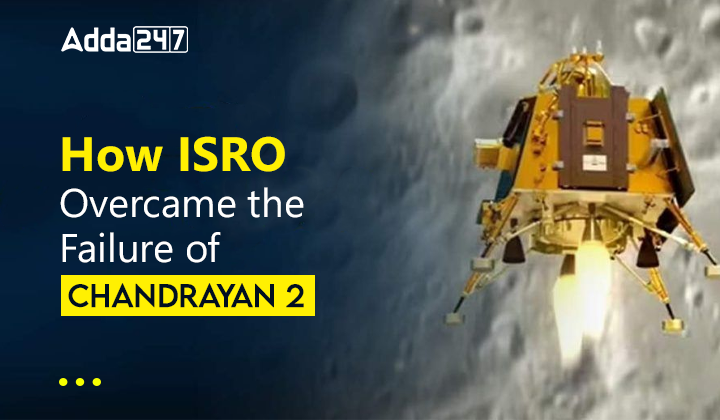How ISRO Overcame The Failures Of Chandrayaan 2?
The countdown has begun! India is on the verge of witnessing another historic moment in just a few hours. Chandrayaan 3 is all set to make its landing on the moon. As the experts say the Chandrayaan 3 landing time will be around 06:04 PM. It’s the time when all the efforts made by our esteemed scientists will pay off. The journey ahead has never been smooth for the Indian Space Research Organization (ISRO). Let’s discuss how ISRO managed to overcome the setbacks of Chandrayaan 2.
Chandrayaan 3 – the third lunar exploration mission by ISRO is poised to take lunar exploration to new heights. It follows the Chandrayaan 1 mission in 2008, which orbited the moon and made significant discoveries, and Chandrayaan 2 in 2019, which included an orbiter, lander, and rover.
Chandrayaan 2 Failure Reasons
Chandrayaan 2, faced setbacks and challenges but ultimately showcased ISRO’s resilience, determination, and ability to learn from mistakes for Chandrayaan 3. This article explores the mission, its mistakes, and how ISRO overcame them.
Chandrayaan 2 landing date was 06 September 2019 (20:23 PM). Its primary objectives were to study the moon’s South Polar Region, land a rover on the lunar surface, and perform scientific experiments. The mission consisted of an orbiter, a lander named Vikram, and a rover named Pragyan.
- The Initial Setback, Lander Vikram’s Hard Landing: The most significant setback in the Chandrayaan 2 mission occurred during the landing phase. On September 6, 2019, as Vikram attempted to make a soft landing near the moon’s South Pole, it deviated from its intended trajectory and experienced a hard landing. The primary reason for the failure of the Vikram lander’s soft landing can be attributed to the following technical and operational factors:
- Navigation and Guidance Anomalies: Towards the end of the landing, the lander Vikram had problems with its trajectory, which caused it to stray from the intended course. A successful lunar landing requires precise navigation and guidance, and any flaws in these systems can result in disaster.
- Communication Breakdown: Mission control was unable to reach Vikram as it descended toward the lunar surface. Due to the connection breakdown, mission control was unable to give the lander real-time guidance and trajectory corrections.
- Altitude anomalies: Vikram’s trajectory diverged from the intended course at an altitude of roughly 2.1 kilometers above the lunar surface, resulting in a hard landing rather than the anticipated soft landing.
- Software flaws: The success of space missions depends heavily on software. Even though ISRO’s software is renowned for its dependability, faults or bugs can still happen. It’s conceivable that Vikram’s anomalous descent was caused by a software flaw.
- The difficulty of Lunar Landing: Because the moon lacks a significant atmosphere and requires precise navigation and propulsion, landing there is inherently difficult. Mission failure can result from even little departures from the intended course.
- Testing Methods: ISRO needs to have used more stringent testing methods to simulate various lunar landing situations and anticipate potential problems.
- The Orbiter’s Success and Ongoing Mission: While Vikram faced difficulties, the Chandrayaan 2 orbiter continued to function exceptionally well. It has been instrumental in capturing high-resolution images, studying the moon’s surface, and detecting water ice in the Polar Regions. This success was a testament to ISRO’s scientific and engineering capabilities.
Leveraging Past Insights
- Rigorous Testing: ISRO recognized the need for extensive testing to simulate various scenarios, especially during critical phases like lunar descent, to identify and rectify issues before they become mission-critical.
- Navigational Precision and Guidance: The precision of navigation and guidance systems is paramount in lunar missions. Chandrayaan 2’s trajectory deviation highlighted the need for advanced navigation techniques and improved guidance systems to ensure a successful lunar landing.
- Enhanced Redundancy: ISRO increased redundancy in critical systems, ensuring that backup mechanisms were in place to mitigate the impact of any failures that might occur during future missions.
- Communication Resilience: ISRO put a greater emphasis on ensuring uninterrupted communication with lunar spacecraft. Improved communication systems and backup plans were also developed to maintain a constant link with spacecraft during critical phases.
- Spacecraft Redesign: ISRO made design modifications to Chandrayaan 3’s spacecraft, incorporating improvements based on the lessons learned from Chandrayaan 2
- Software Tweaks: ISRO also implemented improvements in software design, coding, and testing to prevent software glitches for complexities of lunar landings that could jeopardize mission success.
- Data Utilization: The Chandrayaan 2 orbiter continues to provide valuable data about the moon’s surface and environment. ISRO learned the importance of efficiently utilizing the data collected by the orbiter for mission planning.
- Risk Management: Space exploration inherently involves risks. Chandrayaan 2 reinforced the importance of thorough risk assessment and management in mission planning. ISRO likely implemented even more robust risk mitigation strategies for the current mission.
- International Collaboration: This time, ISRO has placed more emphasis on working with international partners, both in terms of knowledge sharing and resource leveraging. Collaboration across borders can increase mission capabilities and success rates.
- Enhanced Mission Control, Independent Review Boards & Contingency Planning: ISRO made improvements to its mission control facilities, both in terms of technology and personnel, to ensure that mission control teams were better equipped to handle complex situations and make real-time decisions. ISRO also may have established independent review boards to assess mission planning and readiness, providing an objective evaluation of mission parameters and risk mitigation strategies. ISRO developed comprehensive contingency plans for various mission phases, including landing, to address unforeseen challenges swiftly and effectively.
Improved Landing Technologies: To ensure a soft and safe landing of Chandrayaan 3
Let’s break down the key elements of significant improvement in lunar landing technology used in Chandrayaan 3 and understand how it can enhance the precision and reliability of the landing process.
- Image-Based Navigation: Using images for navigation is a robust technique. Chandrayaan-3 can capture images of its intended landing site as it descends, allowing it to recognize features and landmarks on the lunar surface. This image-based navigation can provide real-time data to ensure the spacecraft is on the correct trajectory.
- Comparison with Stored Image Data: By comparing the real-time images with stored image data, the spacecraft can precisely determine its position relative to the intended landing site. This eliminates the need for complex mathematical calculations to adjust its trajectory, simplifying the navigation process.
- Automated Decision-Making: The ability to make real-time decisions based on image data allows for automated adjustments. If the spacecraft detects that it’s deviating from the target, it can make necessary corrections autonomously. This minimizes the need for constant intervention from mission control on Earth.
- Object Detection for Safety: The feature of avoiding objects larger than 30 cm at the landing spot is crucial for ensuring the safety of the spacecraft. It prevents the lander from touching down on hazardous terrain or obstacles that could damage the spacecraft.
In summary, drawing upon lessons from past setbacks and incorporating the cutting-edge landing technology outlined above signifies a significant advancement in lunar landing technology, by which the path to a successful mission becomes clearer. This demonstrates ISRO’s commitment to innovation and progress, specifically in response to challenges encountered in previous missions like Chandrayaan 2. Such an approach holds the promise of improving the effectiveness and efficiency of Chandrayaan 3’s lunar landing, paving the way for more precise and ambitious lunar exploration ventures in the times ahead.
Why Chandrayaan 2 Failed, Know Failure Reasons Here and How ISRO Overcame? Read in Hindi



 Importance of Solving Previous Year Pape...
Importance of Solving Previous Year Pape...
 SSC CHSL Vs. SSC CGL – What Changes in S...
SSC CHSL Vs. SSC CGL – What Changes in S...
 RRB ALP Preparation Strategy 2025, Tips ...
RRB ALP Preparation Strategy 2025, Tips ...


